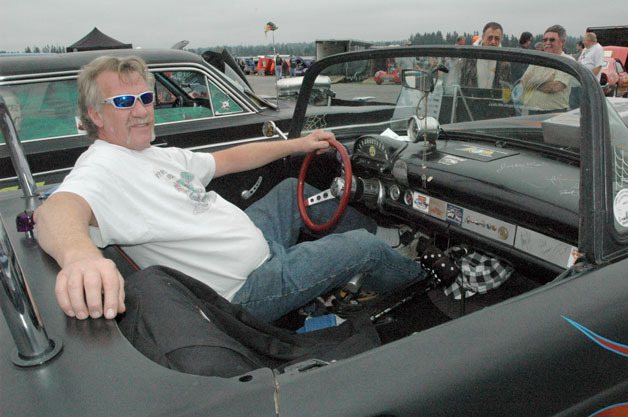ARLINGTON — The 10th annual Drag Strip Reunion and Car Show at the Arlington Airport yielded no shortage of hot rodders and classic car enthusiasts alike, but it also benefitted area charities above and beyond the community groups that are the ultimate recipients of its annual proceeds.
While the final confirmed total of dollars raised for the designated recipients of this year’s show was not yet available as of press time, Jerrie Inman had collected at least $300 in cash and 100 pounds of food for the Arlington Community Food Bank from attendees at the west side entrance of the airport midway through the eight-hour event on Saturday, Sept. 14.
“We need money even more than we do food right now,” said Inman, a member of the Arlington Community Food Bank Board of Directors, as passersby handed her cans of food and dollar bills. “The only way we have to pay for our rent, electricity, garbage and water is through the donations we receive.”
As always, all the admission and entry fees from this year’s show will go toward the Port Gardner Vintage Auto Club’s chosen groups, which this year will include the Boys & Girls Clubs of Arlington and North Everett, the Arlington and Marysville community food banks, the Animal Rescue Foundation, Cocoon House, the Burned Children Recovery Foundation, the Marysville-Pilchuck High School Automotive Program and Open Door Theatre.
“It’s all done by volunteers, so all the proceeds are able to go to those local charities,” said Jake Jacobsen, of the Port Gardner Vintage Auto Club, whose goal was to outdo last year’s collection total of $10,000 by reaching $12,000, although he acknowledged the day’s less than cheery weather might have affected this year’s turnout.
Tom “Big T” McDonald certainly wasn’t deterred by the day’s gray skies. He has owned a 1956 Ford Thunderbird for 17 years and is part of the “Street Freak Kruzrs” of Arlington.
McDonald has been into the hot rod scene since he was a 12-year-old kid who was still riding his bike to check out street racers’ cars, and he expressed pride in his unorthodox choice of a T-Bird for a hot rod.
“Usually, the T-Birds you see are all stock,” said McDonald, whose customized rig boasts 543 horsepower under its hood.
Whereas McDonald’s T-Bird sports a black paint job, complete with images of hot rodding icon Rat Fink, Snohomish hot rodder Rich Chapman pointed to the slogan on his interior sun visor as the reason for his 1942 Ford Coupe’s dull gray exterior.
“Real rods don’t wear paint,” Chapman said. “That’s what hot rodding was all about, before they started putting fancy paint jobs on them.”
The wild exterior of Noel Brown’s 1955 Studebaker is perhaps as far removed from Chapman’s Spartan aesthetic as an antique automobile can get, but then Brown is a tinkerer rather than a hot rodder.
“I bought the body of this car on eBay, but I didn’t like the color,” said Brown, a Bellingham resident, of the bubblegum pink original paint job. “After a while, though, it kind of grew on me, but I didn’t want to just put flames on it so I added splotches of paint just to make it a little different. I studied fine arts in college, what can I say,” he laughed.
Ferndale’s Larry Schaffer brought possibly one of the most unique cars of the show, a 1948 Crosley, whose wheelbase was 13 inches smaller than that of a Volkswagen Beetle.
“It was one of the first economy cars,” Schaffer said of the Crosley, which was sold via mail-order by an American company that also manufactured refrigerators and radios. “I’ll be selling it to finance my next project, though.”
“I like building cars more than owning them,” Brown agreed. “It’s more fun to buy it, fix it up, sell it, then buy something else.”


